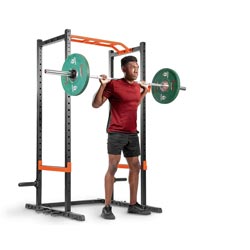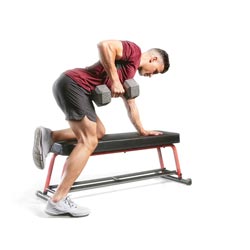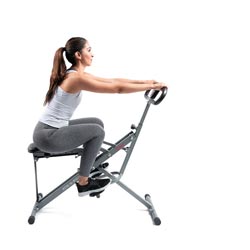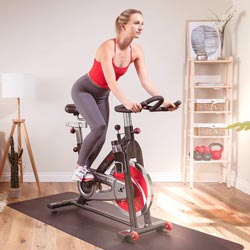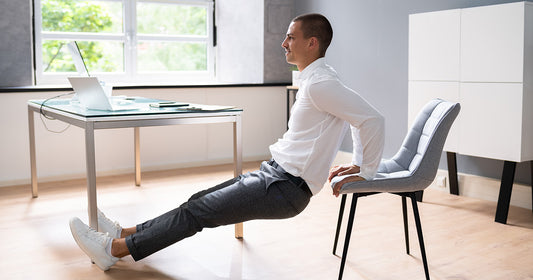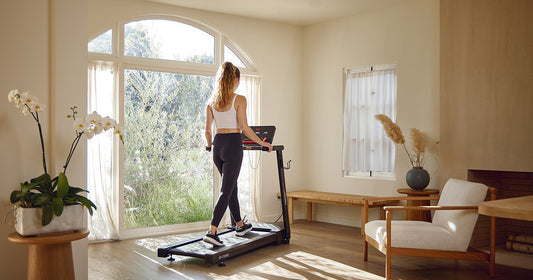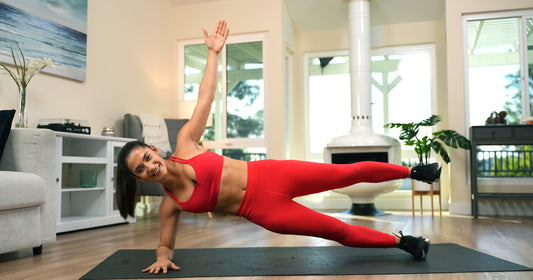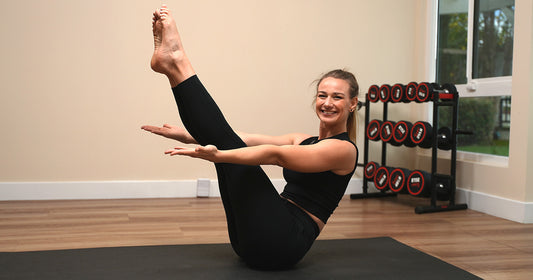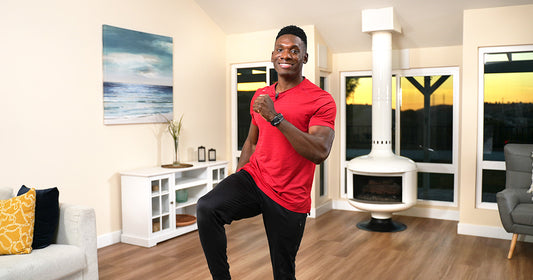Squats are the ultimate lower body compound exercise. Few exercises simultaneously fire up the glutes, hamstrings, quads, and core as efficiently as a traditional squat. Plus, if you’re looking to dip into functional training (read: train to move better in and out of the gym), squats should be at the top of your list.
But what if you lack the mobility and strength to squat with good form or without pain? That’s where squat variations come in. Sure, any squat variation—like goblet squats, sumo squats, or Bulgarian split squats—you can do without pain is a good place to start. But box squats might be your best option.
Box squats are an incredible tool for boosting body awareness, rehabbing nagging injuries, and correcting wonky squat form. Plus, they can give you the edge you need to push past squat plateaus and crush your PR. Here’s exactly how to do them.
What Are Box Squats?
Box squats are exactly like regular squats, except they involve squatting until your butt taps a plyo box (or bench or chair) positioned behind you. You can do box squats with your bodyweight, with a dumbbell or kettlebell held just above your chest, or with a barbell loaded on your back.
Box Squats Muscles Worked
Box squats primarily work your quads, hamstrings, and glutes. But your spinal erectors, hip flexors, lower back muscles, calves, anterior tibialis (front shin muscle), and core work to stabilize your body throughout the movement.
Because box squats involve sitting back with your hips (not unlike sitting into a chair) they activate the posterior chain—or the muscles in the backside of your body, like your glutes and hamstrings—more than your average squat.
Benefits of Box Squats
There are numerous reasons to add box squats into your regular workout rotation. Here are the biggies.
Box Squats Work Your Posterior Chain
When you perform box squats, you sit back with your hips more than you would with a typical squat. This movement pattern helps to activate your posterior chain—particularly, your glutes and hamstrings—even more. By strengthening your posterior chain, you can build better posture, fend off lower back and knee injuries, and generate more explosive strength and power.
Box Squats Improve Your Squatting Form
Consider box squats like a 101 course to proper squat form. Box squats give you the space to practice perfect form with the box as your safety net. They’ll also heighten your awareness of any weak or bad movement patterns in your regular squat and help strengthen them. Practice box squats regularly and you’ll soon notice your squat form is better, even when you take the box away.
Box Squats Put Less Strain on Your Knees
Got knee pain? Make box squats your go-to. While it’s not incorrect to squat with your knees in front of your toes, if you have weak knees or problems with knee pain, keeping your knees behind your toes during a squat can stave off pain. Box squats encourage your knee to track behind your toes naturally as you shift back with your hips.
Box Squats Can Help Rehab Injuries
While you should always make sure you’re cleared by a doctor or physical therapist before doing a movement, box squats can be a great way to retrain your body after an injury. Choose a taller box to start working on smaller movements at partial heights, focusing on form. Progressively work with smaller boxes as your strength improves over time.
Get Stronger at the Bottom of Your Squat
If you’re looking to smash a PR, box squats can help you get stronger and bust through strength plateaus. How? The hardest part of a squat is the “sticking point”, or when you push from the lowest point in your squat to stand up. Box squats hammer the sticking point because you can’t use your momentum, which forces you to use pure strength to get back up. The TL; DR: they help you get stronger in the hardest part of your squat.
How to Do Box Squats With Perfect Form
Ready to incorporate box squats into your routine? Here’s how to do a box squat with perfect form:
- Set up a box, chair, or bench. Stand a few inches facing away from the box with feet slightly wider than hip-width apart, knees slightly bent, and toes pointed straight forward or slightly out. Splay your toes wide and grip the floor with your feet.
- Roll your shoulders down and back, keep your chest up, and engage your core.
- Take a deep breath, sit back with your hips, then bend at the knees to lower until your butt touches the box.
- Gently tap the box (avoid sitting on the box as you’ll lose tension), pausing at the bottom of the rep.
- Push through your midfoot and heel, while keeping your toes connected to the ground.
- As you stand, keep your chest high and squeeze your glutes to drive your hips forward, and exhale on the way up to return to standing.

How to Add Box Squats to Your Workout
From here, how you incorporate box squats into your workout depends on why you’re incorporating them, but there are a few things that always ring true.
- Find the right box. The perfect box will be just above where your form starts breaking down, your injury starts speaking to you, or your mobility becomes a limiting factor. If you’re injured or a beginner, opt for a box height that’s a little higher to start, you can always progress to a lower box as you gain strength and confidence.
- Progressively use smaller boxes over time. Ideally, the goal is to work up to a squat depth of at least 90 degrees (with your hips in line or below your knees) with perfect form—at this point, your glutes and hamstrings activate to a higher degree, meaning you’ll get more out of every rep.
- Always use a weight you can control, even if that means using only your bodyweight. Gradually increase the load overtime as you build strength. At the right weight, you’ll be able to complete a decent amount of reps with perfect form and without pain.
Once you have the above locked and loaded, consider how to incorporate box squats into your routine with these tips.
Rehab an Injury
If you’re using box squats to rehab from an injury, your reps should always be dictated by your range of motion, mobility, and pain. Listen to your body over general rep, set, and depth cues. Set individual goals based on the range of motion that you have, and stop immediately if you have pain.
Beginner
If you’ve never squatted with weight (or it’s been a long time), start with bodyweight box squats. Aim for 3 to 5 sets of 12 to 15 reps.
Intermediate
If you’re looking for a solid squat variation to add to your routine (with the added bonus of hammering your form) grab a heavy kettlebell and try 3 to 5 sets of 6 to 12 reps of goblet box squats.
Advanced
If you’re chasing a PR, load up a barbell and try 3 to 5 sets of 4 to 6 reps. Do yourself a solid and start on the lighter end—barbell box squats are tougher than they look. Focus on slowing down the eccentric portion of the squat (or the lowering phase) and exploding with power through the sticking point.
Frequently Asked Questions
You’ve got questions about box squats, we’ve got answers.
What’s the difference between a box squat and a regular squat?
Box squats and regular squats have many similarities—they both build lower body hypertrophy and strength and involve training a functional movement pattern you use everyday. Box squats specifically are great for increasing posterior chain activation (hamstrings and glutes), reducing knee pain, and addressing the sticking points in a regular squat.
Is a box squat ‘cheating’?
Nope. Since box squats remove momentum from the lowest point in your squat, they can be more difficult because you have to rely on your strength and control to complete each rep.
Is a box squat easier or harder than regular squats?
Box squats are more difficult than regular squats. Why? Box squats force you to squat with good form and use your strength rather than your momentum to muscle out each rep.
What equipment can you use in a box squat?
Most people use a plyo box to complete a box squat, but you can use a bench, chair, or sofa to get the job done. Choose a surface that’s sturdy enough to support your bodyweight and any additional weight you’re working with.



